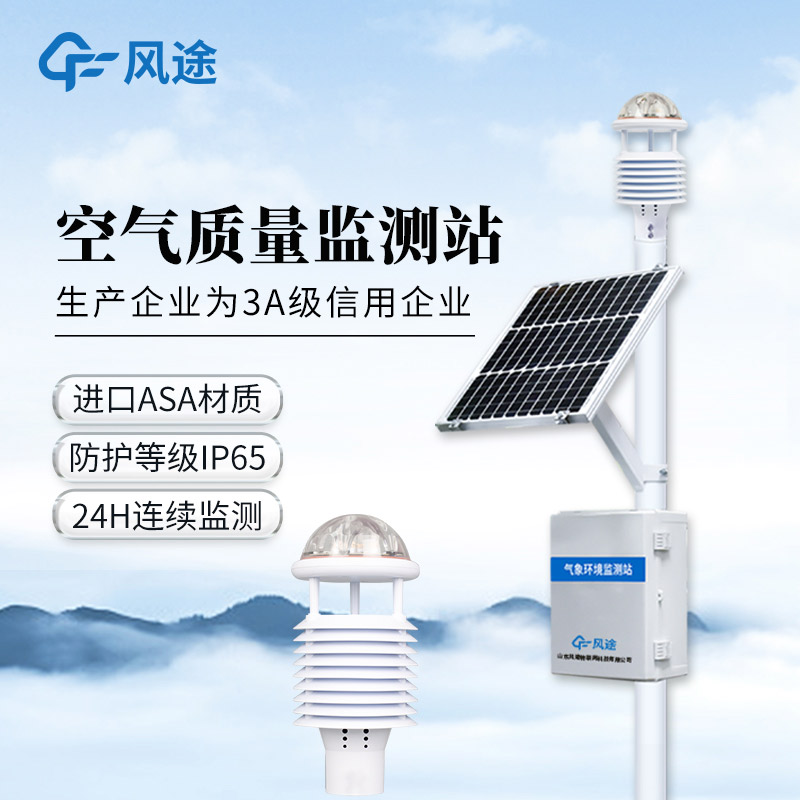Shandong Fengtu IOT Technology Co., Ltd
Sales Manager:Ms. Emily Wang
Cel,Whatsapp,Wechat:+86 15898932201
Email:info@fengtutec.com
Add:No. 155 Optoelectronic Industry Accelerator, Gaoxin District, Weifang, Shandong, China

Sales Manager:Ms. Emily Wang
Cel,Whatsapp,Wechat:+86 15898932201
Email:info@fengtutec.com
Add:No. 155 Optoelectronic Industry Accelerator, Gaoxin District, Weifang, Shandong, China
time:2025-04-22 09:22:12 source:Weather Station viewed:11 time
The quality of the atmospheric environment is closely related to the survival and development of human beings. Precise and real-time monitoring serves as the foundation for understanding the state of the atmospheric environment and formulating control measures. As important tools for atmospheric environment monitoring, the Air quality monitoring station and the Dust detector play a significant role in environmental supervision.
The Air quality monitoring station is capable of monitoring "four gases and two types of dust". The "four gases" refer to sulfur dioxide, nitrogen dioxide, carbon monoxide, and ozone, while the "two types of dust" are PM2.5 and PM10. Its advantage lies in its flexible deployment. According to the distribution of urban functional areas and pollution sources, it can be densely installed within the region to construct a grid-based monitoring network, achieving refined and comprehensive coverage of the monitoring of atmospheric pollutant concentrations. Through real-time data transmission and analysis, it can promptly identify pollution hotspots and the diffusion trends of pollutants, providing accurate decision-making bases for environmental management departments.
The Dust detector is mainly used to measure PM concentration and noise. In places prone to generating dust, such as construction sites and mining areas, it can monitor the real-time changes in the concentrations of PM2.5 and PM10 in the air, and also monitor the noise intensity on-site. This instrument has the functions of automatic data collection, storage, and remote transmission. Once the PM concentration or noise exceeds the set threshold, it will automatically alarm, making it convenient for relevant units to take timely dust and noise reduction measures, effectively controlling dust pollution and noise pollution, and ensuring the quality of the surrounding environment.
The Air quality monitoring station and the Dust detector provide data support for atmospheric environment monitoring from different dimensions. The former focuses on comprehensive monitoring of macroscopic regions, while the latter is dedicated to precise control of specific pollution sources. Complementing each other, they jointly contribute to the work of atmospheric environment monitoring, providing powerful technical support for improving air quality and promoting the construction of ecological civilization.

Atmospheric monitoring stations and Air quality monitoring stations are two different facilities in the field of environmental monitoring, each undertaking different monitoring tasks and functions. Atmospheric monitoring stations mainly undertake national-level environmental monitoring tasks. They a...
The five elements micro meteorological instrument is a practical meteorological observation tool, which has the ability to simultaneously monitor the five core meteorological parameters: wind speed, wind direction, temperature, humidity and atmospheric pressure. The device provides real-time informa...
Transmission lines often extend over tens or even hundreds of kilometres, traversing diverse terrain such as hills and plains, passing through farmland, villages, industrial areas and forests. Due to the variable geographical and climatic conditions along the route, transmission lines are exposed to...
A portable visibility sensor is a device capable of measuring the brightness of the surrounding environment and the visibility of the atmosphere. It usually uses laser or infrared technology to provide visibility data quickly and accurately by measuring parameters such as light scattering and reflec...